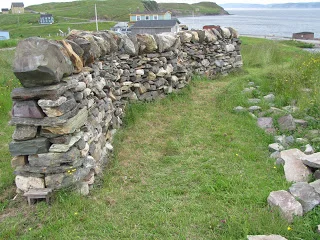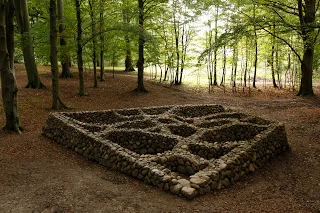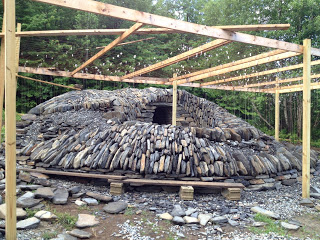The 34-stone construction is made from stream-worn “pillow” basalt boulders gathered from a gravel bank along the Santiam River in Mill City, Oregon and 70 year-old hand split, cast-offs collected from an abandoned granite quarry in Haines, Oregon. The stones are held in place by gravity and friction aided by stainless steel pins for lateral strength. The total weight of the piece is 15 tons, the largest stone weighing 4 tons. The piece covers a 10’x30’ area and is 6’ tall at it’s highest point.
Read MoreThe 34-stone construction is made from stream-worn “pillow” basalt boulders gathered from a gravel bank along the Santiam River in Mill City, Oregon and 70 year-old hand split, cast-offs collected from an abandoned granite quarry in Haines, Oregon. The stones are held in place by gravity and friction aided by stainless steel pins for lateral strength. The total weight of the piece is 15 tons, the largest stone weighing 4 tons. The piece covers a 10’x30’ area and is 6’ tall at it’s highest point.
Read MoreI’m delighted by this new-found perspective which has been amplified this past week by my being in Bend, Oregon. The city of 80,000 has doubled its population in the past 20 years. The increase is due in large measure by the influx of people like Jeff Fairfield and his wife Samantha. Both Maine natives, they moved to the Bend area 6 years ago to begin their careers building dry stone walls and teaching horseback riding. Jeff’s joining me on the Tarriance at COCC this week got the project off to a great start. After taking delivery on 15 tons of stone we made full-scale, foam board, mock-ups of the individual pieces. With them I could quickly try out different granite slab and basalt boulder arrangements.
Read MorePast workshops have sketched a wave on the footprint of a derelict old field wall by establishing a guide frame with rope and artist easels, and bringing stones to points just under the line. Another group hiked to a remote beach and made a circle of stones on the crest of the high-water mark. It was only a visible as a piece of environmental art from the air. The English Harbour village and coastal cliffs along the famous Skerwink Trail were also viewable from Dave Paddon’s float plane.
Read MoreThe last day on our transcontinental journey begins in Twin Falls, Idaho. By this afternoon we should be at our Oregon destination for the installation of a sculpture at the Central Oregon Community College. The O.H. and I have tag-team driven from Eastern Newfoundland across three provinces and twelve states in the past week and a half with just a 2-day stop at home in Vermont to unpack and repack the car. The weather has been cooperative, only occasional rain-storms and wind gusts to impede our westerly progress.
Read MoreEach morning a pair of loons fly from the high forest pond behind the house to the wide ocean bay at the bottom of the road. In the evening they make a return flight. They punctuate their daily routines with an intermittent call and response, stuttering laughs that draws me out onto the deck to watch them wing past. This is high entertainment in the TV and internet-free environment I’ve been living in the past two weeks. The radio here is powered by a hand crank. After five minutes of broadcast the signal cuts out and I have to decide if the listening is worth the effort to recharge the battery.
Read MoreWe must have done something right in a former life to get so lucky with the week’s weather during the recently completed English Harbour Arts Centre (EHAC) dry stone workshop. Seven participants from two provinces and three states worked under nearly rain-free skies for five days designing and building long-lasting walls and ephemeral art. Some of us even took a dip in the bay; a rare occurrence in Newfoundland waters.
Read MoreThe last five pages of my notebook are covered in boulder sketches. Each one records the shape and dimensions of a large stone in Edward Tufte’s growing stock yard of material pried loose from ledges on his Hogpen Hill Farm. The pencil sketches are the first step in a method of discovery I’ve employed for designing megalithic constructions since 1981 when I won a NEA grant for studying amphitheaters. From the drawings I fashion ¼” -1’ clay models of the stones. With the clay pieces I can try out a variety of construction configurations before confronting the actual boulders. The small-scale assemblages allow for freedom to experiment with different design concepts.
Read MoreWhen I began building stone features on Richard Epstein’s property more than ten years ago he had a unformed, but long term vision of the space around his cabin. He wanted to keep the sequestered feel of being in the deep woods. He also wanted to armor the slopes surrounding his home with stone. To this end, we began by building a sunken patio to the southeast with stepped paths leading to a pond. A few years later, a raised pyramid, fire pit patio was created to the northeast. Stone steps replaced wood stairs at porch entrances.
Read More"Working hands inform thought and awaken understanding of the art builder's place in the natural world. Undulant lines and patterned spaces are the result of many choices made by the builder who recognizes, and utilizes, the unique character of stone"
- Dan Snow
My time in the eye of the stone has passed. Yesterday saw the final vertical pieces set in the Horse Eye sculpture. Phase One is complete except for two elements being carved by Chris Curtis of West Branch Gallery in Stowe, Vermont. They will be lowered into place at a later date, replacing the styrofoam mock-ups. The carved pieces will represent the “third eyelid.” The third eyelid of a horse is the lightning-fast flap that zips across from the inner corner to seal the eye shut against threat even before the lids can close. It's also the source of lubricating tears.
Read MoreYou have to love a state whose official rock is a petrified “burp.” Large areas of the land that is now the state of Oregon had bubbly, silicic lava periodically flowing out of it for 11 million years. The lava cooled and became buried. Water got into the hardened shell of the gas nodules and brought mineral solutions which eventually turned to agate. Today those geologic anomalies are called “thunder eggs.” Dan Dunn, owner of Alpine Boulder Company, showed me around the inventory of his stone yard. I was amazed by the size and quality of thunder egg, petrified log and basalt column specimens at his Helix, Oregon location. Dan owns or leases properties in Oregon with mineral potential. He prospects for special stones and makes them available to wholesale customers.
Read MoreLaboring in stone-craft is sweaty business even when the summer air temperature is moderate. Ramp the heat up to 95° F (35° C), add the radiant heat steaming off the stones, and I find myself working in a veritable, solar bake oven. The perspiration really starts to flow. Dust swirling around the site sticks to damp clothing and exposed skin. I look like a coal miner by the end of the day. I’m not complaining, though. Extreme heat is preferred over cold. My aging muscles and joints definitely perform better in summer weather.
Read MoreStone hunting for The Tarriance sculpture project recently took me on a 1,300 mile, Oregon road trip. The trail led across dry shrub-lands, over evergreen-spired mountain passes, and along deep river gorges. In the west, three basalt boulders were located in a riverside gravel pit. In the east, slag from an abandoned granite quarry netted the thirty pieces I’ll use to construct the “raft” that the boulders will rest upon.
Read MoreWhile nature abounds all around I try to focus on the work at hand. The methodical labor of setting vertical stone to shape the sculpture requires a steady concentration. Each piece has to slot in between previously set stones, and has to be bedded in the crushed stone so that the top face aligns with the developing form. On the highest portions of the work, I measure the next space to be filled, climb down to find an appropriate stone, hammer shape it if necessary, and climb back up to set it.
Read MoreIt was excavator ballet at Hogpen Hill Farms this week. I had four machines at my disposal for the assembly of stone structures. Under Edward Tufte’s direction, the polite march of table tops created during previous sessions evolved into a stagger of dolmens. The new pieces, inspired by ancient lithic structures, progressed south along a wooded ridge-line in combinations of two, three and four stones.
Read MoreA collaborative design process culminating in the hands-on creation of a dry stone structure. Instruction in design will include site assessment, 3-D modeling and guide frame set up. Instruction in building with loose stone will include identifying each stone’s best use, applying the four basic principles for strong construction, and practicing safe methods for shifting and lifting stone. One day of the workshop will be devoted to working in nature to create a temporary environmental art piece.
Read MoreShowers every day added up to 2” of precipitation and sloppy working conditions at the stone eye project this week. Safety glasses fogged and the mud sucked at my boots but I was glad to be outside making progress on the construction. The lead-sinker hanging guide-point system is proving to be very reliable and flexible. When I need to move a group of points out of the way to pitch stone into the center, I simply swing them up to the wire grid and hook them there temporarily. As I finish an area of stone work I unclip and remove the point lines.
Read More
















